| Part 2
Economics |
| DCE Yuichiro Hayashi, Y.
Hayashi |
|
| December
2003 |
|
| Chapter
1 Examination of Keynesian Multiplier
Effect Theory |
|
| §1
Outline
of the examination
of the Keynesian multiplier effect theory |
|
| Keynes'
principle of effective demand based on the Keynesian multiplier effect
is mathematically wrong.
|
| The
Keynesian multiplier
effect doesn't exist. |
|
| In order to avoid complications on symbols, we
shall consider a closed economy. Let Y be
the gross value added (GVA) in the national economic accounting. Furthermore,
the following notations are defined: Y3
= the gross value added; Y2
= demand( final products from the standpoint of customers) or
supply( those from producers); Y1
= gross income( the value to which the GVA
is distributed to firms, households and a
government). In this literature the terms GVA (or Y)
and GDP are mainly used in incomes and expenditures, respectively. |
|
| The author adds the following definitions: Y3
= input in economic activity ( costs and profit in
final products); Y2=output
in economic activity ( final products with stocks). Y1= both
a broken-down value and
the residual one, from the value Y2, which are
carried into Y3 as
its generation resources |
|
| By applying the managed gross profit theory to the input-output
table in the national economic accounts, an input-output table chart shown in
Fig. 2-7 has been derived. Fig. 2-7 shows the relationship between
output( final product) and inputs( gross value added). In this chart, we can't find the
'marginal propensity to consume (MPC)', |
|
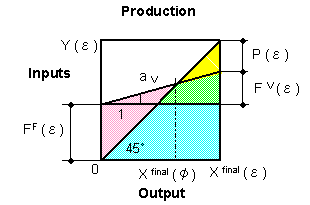
|
|
Fig. 2-7 Input-output table chart |
| where |
| Y= gross value added (=GVA), (ε): it shows that data are those at
the end of a yearly accounting period, X final= final
products,
Y (φ) = break-even products of Y, P= operating
surplus, |
| FF= fixed costs in
GVA, FV= variable costs in GVA, aV = variable cost
ratio = FV / Y. |
|
| The coefficient a V corresponds
to the variable
cost ratio in a firm's break-even chart. A
change in Y is the total change in both FV and [P+FF]. |
|
| From the
national economic accounts at the Keynesian cross, we have the
following equations: |
|
Y2 = C 2 + I 2
+ NX 2 + G 2
(3-R1) |
|
Y2 = Y1
(3-R2) |
| where Y1
= gross income, Y2 = final products, C2 =
consumption, I 2 = private investment, G2 =
government expenditure, NX2 = exports -
imports, |
| At the new Keynesian cross after the
remove from Y to Y
+ ΔY, we have: |
|
ΔY2 =Δ
C 2 + ΔI 2
+ ΔNX 2 + ΔG 2
(3-R3) |
|
ΔY2 =Δ Y1
(3-R4) |
|
| From Eq. (3-R3),
we have: |
|
Δ
C2 / ΔY2 + ΔI 2 / ΔY2+
ΔNX 2 / ΔY2+ ΔG 2
/ ΔY2 = 1 (3-R5) |
Substituting Eq.
(3-R2) into
Eq. (3-R5) gives: |
|
Δ
C2
/ ΔY1 + ΔI 2
/ ΔY1+ ΔNX 2
/ ΔY1+ ΔG 2
/ ΔY1 = 1 (3-R6) |
|
| We adopt the
following assumption: |
Assumption 1
; The following statistical coefficients exist; aK =
MPC = Δ
C 2
/ ΔY1 , a
I
= Δ I 2 /
Δ Y1, aNX = ΔNX2
/ ΔY1
and aG = ΔG2
/ ΔY1,
where all the coefficients are constant. |
| From Eq. (3-R6), between these
coefficients, we have the following: |
|
aK + aI + aNX
+ aG =1
(3-R7) |
|
| Eq. (3-R6) can be
transformed to: |
|
aKΔY1 + ΔG 2 + ΔI 2
+ ΔNX2 =
ΔY1
(3-R8-1) |
| that is, |
|
ΔY1 = ΔG 2
/ (1− aK) + (ΔI 2
+ ΔNX 2 )
/ (1- aK)
(3-R8-2) |
| Transforming Eq.(3-R7) gives: |
|
aK +
aI + aNX +ΔG 2
/ ΔY1 = 1
(3-R9-1) |
| that is, |
|
ΔY1 = ΔG 2
/ (1 - aK -
aI - aNX )
(3-R9-2) |
| Eq. (3-R5), Eq.
(3-R6), Eq. (3-R8-2) and
Eq. (3-R9-2) are equivalent to each other under Eq. (3-R4) and
Assumption 1. |
|
| Eq. (3-R7) can be explained in Fig. 4-3. |
|
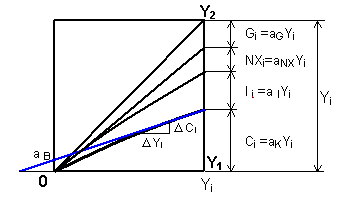
|
|
Fig. 4-3 Meaning of aB or Relationships between coefficients |
|
| The multiplier effect by the Keynesian
model is shown in Fig. 3-3. |
|
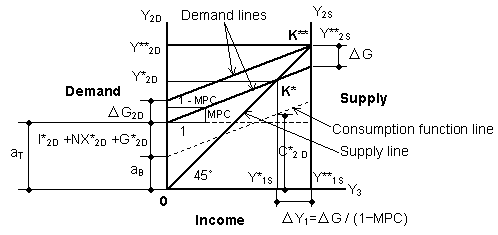
|
| Fig. 3-3 Keynesian multiplier effect
chart |
|
| The multiplier effect equation by Keynesian
model is
as follows: |
|
Δ Y1= Δ G2 / (1 - aK)
(3-13-1) |
| Eq.(3-13-1) is obtained by
adding the
following assumption, into Eq.(3-R8-2),: |
| Assumption 2: ΔI 2
= ΔNX 2 = 0 |
| Then, under Assumption1,
Eq.(3-13-1) is equivalent to Eq.(3-11) which has been gotten by substituting Assumption 2
into Eq.(3-R1) . |
|
ΔY2 = ΔC2 + ΔG2
(3-11) |
| Eq.(3-11)
expresses that ΔC2
and ΔG2 are already generated at the same time. |
|
| In fact, we have overlooked for a long
time that ΔC2 is
hidden from sight in Fig.3-3. Thus, Fig.3-3
is wrong in the expressing way of ΔY2 even if we
allow the Assumption 2. Fig.3-3
must be drawn as shown in Fig. 4-6.
We can't
find the multiplier effect in Fig.4-6. |
|
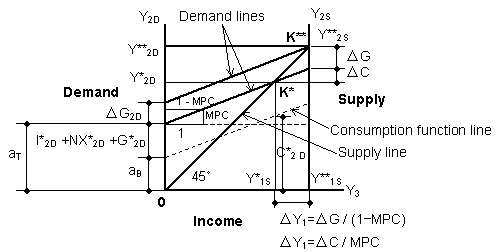
|
|
Fig. 4-6 Corrected Keynesian multiplier effect
chart |
|
| As I2 is
largely affected by a change of Y2 in the real economy,
(aI +aNX)
is not zero in Eq.(3-R9-2). Hence, we can't
adopt the Assumption 2, so Fig.4-6 doesn't hold. If we adopt the
Assumption 2, aK will
become a nonlinear function of Y1. In addition,
if we adopt the Assumption
2, the output amount corresponding to the partial outputs, Δ I2 and ΔNX2 is lost
(the amount Δ C2 +ΔI2 is a part of the
GVA) from the total ΔY2 ,
although ΔY1 expresses the total input (ΔY1 is
the whole of the GVA). That is to say, the Keynesian cross condition ΔY1= ΔY2
is not satisfied. |
|
| However, this assumption
is not the fundamental cause in errors in the Keynesian multiplier
effect theory. If an incremental final
product is only ΔG2 in Eq.(3-R3) and Eq.(3-R4) , that
is, ΔG2 = ΔI2 = ΔNX2 =
0, the following equation should hold: |
|
ΔG2 =
ΔY2 = ΔY1
(1-1) |
|
| Despite Eq.(1-1), ΔC2 is
already generated with ΔG2 in Fig. 4-6. Consequently,
Fig.4-6
is wrong for only ΔG2. For only ΔG2, Fig. 4-6
must be correctly replaced by Fig.4-7. |
|
|
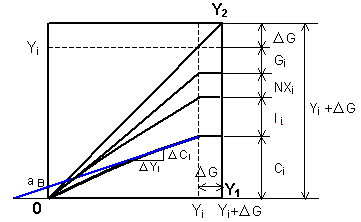
|
|
Fig.4-7 Correct ΔG-Y chart |
|
|
|
When ΔG2 and
ΔNX2 are included in ΔIT, this
economic model is used in J. M. Keynes' original work, although he didn't show its model chart. When we express aB
as IT and ΔG2 as ΔIT
in Fig.4-6( above), we can name this chart 'Keynes'
original chart' which is shown in Fig.5-5( below).
|
|
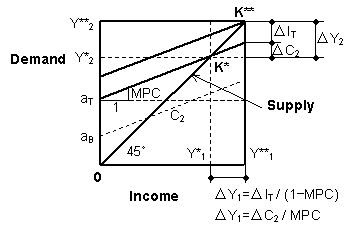
|
|
Fig.5-5 Keynes'
original chart
|
|
|
|
According to the author's consideration made in 5.3,
§5, we can't use Keynes' original chart
theory for analyzing an economy which changes with respect to time.
Keynes'
original chart model is a two-degrees of freedom system in which the variables
are both C2 and I2,
and Y2 is a dependent
variable. Just when Keynes
assumed the existence of the MPC, one constraint condition is added to the
system to create a one-degree of freedom system. ΔC2
depends on ΔIT, and so both ΔC2 and ΔIT don't relate to the passage of time. This
relationship is shown in Fig.5-4( below) where Δx = ΔC2, Δy = ΔIT,
and Δz = ΔY2.
|
|
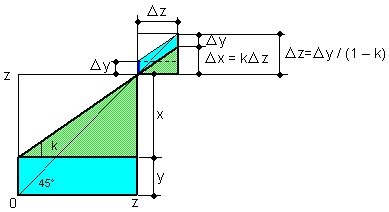
|
|
Fig.5-4 One-degree of freedom system
|
|
|
| The most important
shortcoming in Keynes'
original chart theory is that the MPC relationship
is broken off in capitalist free
economy countries just when we intend to add an incremental government
expenditure to resolve an unemployment problem. To resolve this
problem, we must simultaneously and surely provide goods ΔC2,
ΔI 2
and ΔNX2 according to
the incremental demand ΔG2 which doesn't relate time passing
. |
|
|
|
However, the MPC is actually found by statistical
observations of the real economy as shown in Fig. 3-1. How can the MPC be observed in the real economy?
|
|
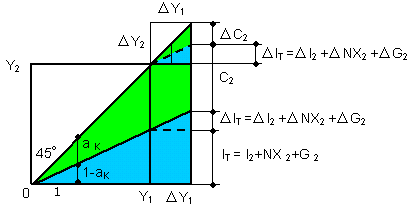
|
|
Fig. 3-11 Corrected Keynesian multiplier effect model
|
|
|
|
The author thinks that the MPC can be obtained only when
we look at the resultant data of consumption in a many degrees of
freedom in a stationary economy. By virtue of both endeavoring to keep
each firm profitable and the national propensity to consume, the
MPC
would have been kept constant in the stationary economy.
|
|
|
| Fig. 2-7( above) is equivalent to
Fig.3-13( below) which has
been gotten in such a manner that ΔG2 increases
from Fig.2-7. |
|
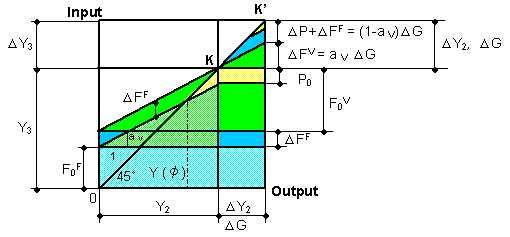
|
| Fig.3-13 Correct ΔG-Y
chart |
|
| The author claims the following: |
| (1) Fig.
3-3 which shows the
Keynesian multiplier effect is wrong. Fig. 3-3 must be correctly drawn as shown in Fig.
4-6. In Fig. 4-6, we can't find
the multiplier effect. However, in Fig. 4-6, ΔC2
is already generated with ΔG2,
so Fig. 4-6 is also wrong (incorrect/ flawed) for only ΔG2.
Nevertheless, Fig. 4-6 is absolutely wrong, because the Keynesian-cross condition
ΔY2 = ΔY1 is not satisfied. Consequently,
the principle of effective demand by J.M.keynes is clearly wrong as far
as we use Eq.(3-13-1) as
a means of solving an unemployment problem. |
|
| (2) When ΔG2 and
ΔNX2 are included in ΔIT, this
economic model is used in J. M. Keynes' original work. As Keynes'
original chart model is a one-degree of freedom system, both ΔC2
and ΔIT do not relate to the passage of time . Consequently, ΔC2
according to ΔIT must
be simultaneously provided to keep the MPC condition when we provide ΔIT
in order to
resolve an unemployment problem. That is to say, both ΔIT
and ΔC2 are in one pair, and
their activities can't be separated. Keynes'
original chart theory doesn't help when analyzing an unemployment problem. |
|
| (3) For the Keynesian multiplier effect chart which belongs to the time
series type chart, Fig.4-7 is
correct. However, Fig.3-13 which belongs to the break-even type chart
is
correct
for analyzing economic problems. |
|
| (4) A
new matrix equation connecting each component of the gross
value added to that of the final products has been presented in Chapter
2 in
order to explain the validity of Fig.2-7 by Leontief's input-output table. |
|
| In conclusion, the
Keynesian multiplier effect theory
Is mathematically wrong. |
| Dec.
2003 Yuichiro Hayashi, http://www11.plala.or.jp/yuichiro-h/ |
| Slight modification Aug. 2008 |








